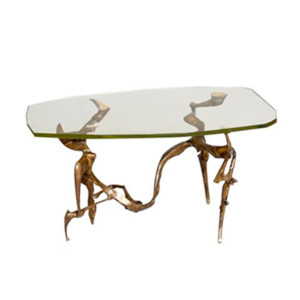SIDO THEVENIN (1934 – 1986)
Born in 1931 in Cote d’Azur, Francois Thevenin is an exceptional architect, sculptor, and furniture-designer who has worked primarily in metal and wood since his early start in the 1960’s. Throughout his career, he has designed and created a wide range of objects, from chairs, to coffee tables, to lamps, door handles, and banister railings. His working process has tended away from cast-metal objects and towards the more intuitive and sculptural, but extremely labor-intensive method of hand-forged pieces. This means that some pieces have required over three hundred hours of manual labor. More significantly, however, such a working method demands that each piece be designed for a specific space. His furnishings are not meant to be reproduced, but to stand as singular, sculptural objects. His furniture bears the indelible mark of his hand, and calls into question the traditional divisions between the functional or decorative, and the fine arts.
He has been known to work quite unconventionally, sometimes pounding an entire chair out of a single steel tank, and sometimes allowing a finished wooden surface to lie untouched in his studio for almost forty years before finding the right use for it. Stories such as these reflect his intuitive practice and seem to corroborate his fluid aesthetic.
In his youth, Thevenin graduated from the prestigious and renowned Ecole des Beaux-Arts of Paris. His time studying fine arts has injected both his working style and his finished products with the decidedly organic and sculptural sensibility that so defines them. Soon after his graduation, he began a career as an architect and furnishing-designer, and it was in these two realms that he made his mark on the world. However, it seems that the urban Parisian lifestyle was not conducive to Thevenin’s interests in the natural world, and in the 1960’s he returned to the French countryside to live and work.
Thevenin has always been profoundly influenced by the natural landscape of France. His work, which emphasizes an organic aesthetic, reflects the values of “the house landscape” movement that he co-founded with architect Jacques Couelle, with whom he has collaborated with closely throughout his career. The philosophy of the movement, which seeks a synchronicity between natural and human-built environments, has resulted in the twisted, branch-like metal work and organic, irregular shapes of Thevenin’s designs. There is both a whimsy and a weight to Thevenin’s furnishings, which convey in their sturdy elegance the gravitas of the natural world and the strength of the hand that forged them.
Thevenin’s collaborations with Jacques Coulle, known as the “architect of billionaires” for the extravagant and unusually villas he designed for high-paying patrons, proved the perfect opportunity for him to exercise his sculptural and technical genius. One of the best-known collaborations occurred with Coulle’s designs for the houses of Castellaras—an unusual resort of villas located on the Cote d’Azur, roughly one hour from Nice, and also on La Costa Smeralda and Calle dei Volpe in Sardegnia. Coulle’s Gaudi-inspired architecture, marked by fluid passages between rooms, undulating walls and ceilings, and a total lack of straight lines demanded that Thevenin produce highly specified furnishings and architectural hardware, such as door handles, for its interiors. Just as Couelle’s idiosyncratic homes appear to grow organically from their natural environment, so Thevenin’s furniture, window panes, and door frames extend from Couelle’s man-made environment. The result is a living space that functions, both visually and practically, as a sort of unified organism.
Thevenin worked for a much of his career alongside his late wife, Sido, oftentimes collaborating on one sheet of metal simultaneously. Photos of the couple at work in the 1980’s reveal that Thevenin and his wife were not only influenced by their natural surroundings, but would sometimes actually work outdoors, hanging slabs of metal from trees or scaffolding in order to weld them or manipulate their shapes. Images such as these testify to Thevenin’s intimate relationship to the natural world and the authentic impact it has had on his development as an artist and designer.
Now in his late 80’s, Thevenin continues to collaborate with Couelle’s son, Savin, on large-scale international sites. The natural environment remains a prime source of inspiration for him. While little is documented of the artist and designer’s life, his work exists as a testament of the potential to break down barriers, both between natural and human-created environments, and between the so-called decorative and fine arts.
Aaron Mayper and Haim Manishevitz for Primavera Gallery
Showing the single result


